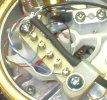Is there any record player now with a balanced output interface?
There are others but here are a few:
Pro-Ject X1 B and X2 B,
THORENS TD 1601,
THORENS TD 550,
From Audiogon
lewm
12,590 posts
11-23-2023 at 12:46am
A turntable is a passive device. It has nothing to do with signal processing or amplification. Same goes for a tonearm. If you want to operate in balanced mode, you simply connect your cartridge to any suitable phono stage that incorporates balanced circuitry. Nearly all cartridges can deliver a balanced signal, if connected to a balanced phono stage such that the “ground” pins from the cartridge carry instead the negative phase of the signal. By convention the “hot” pins carry the positive phase. Positive goes to pin 2 of an XLR. Negative phase to pin3. Pin 1 is for chassis ground but the phono signal floats.
imhififan
2,141 posts
11-24-2023 at 02:01pm
MC cartridge and almost all MM and MI cartridge except those wired its negative to ground are balanced device. If you’re looking for a turntable with cartridge and XLR connection for under a grand, just shop for a turntable and cartridge that is within 1k budget and rewire the phono connection to XLR cable.
lewm
12,590 posts
11-23-2023 at 01:13pm
So, if you already own a balanced phono stage, you would remove the RCA plugs from your phono cables. Then solder the bare lead that was connected to the center plug of the RCE to pin2 of an XLR. The bare lead that was connected to the outer barrel or ground of the RCA would connect to pin3 of the XLR. If the RCA cable has a shield, connect the shield to pin1. It is best if your RCA uses separate conductors for hot and ground where ground is distinct from the shield. This scenario holds where the cable runs direct from the cartridge pins or from a DIN plug or from an outboard box.

